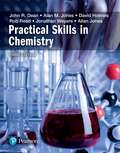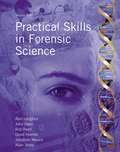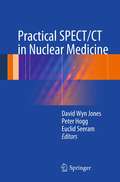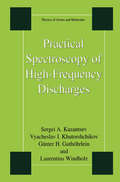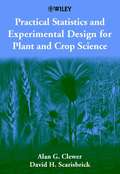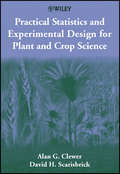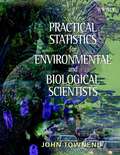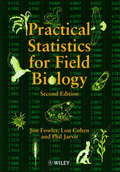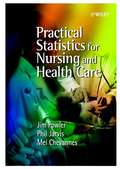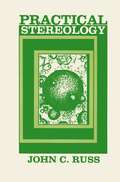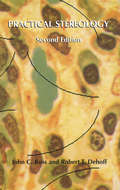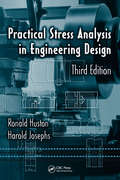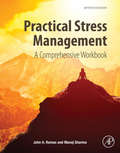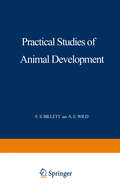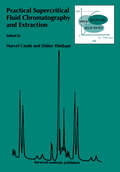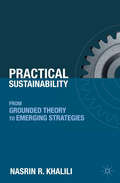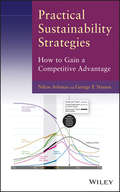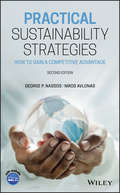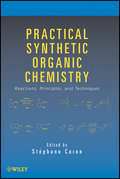- Table View
- List View
Practical Skills in Chemistry (Practical Skills)
by Dr Jonathan Weyers Prof Author Dr Allan Jones Prof John Dean Dr David A Holmes Dr Alan M JonesPractical skills form the cornerstone of chemistry. However, the diversity of skills required in the laboratory means that a student’s experience may be limited. While some techniques do require specific skills, many of them are transferable generic skills that are required throughout the subject area. Limited time constraints of the modern curriculum often preclude or minimise laboratory time. Practical Skills in Chemistry 3rd edition provides a general guidance for use in and out of practical sessions, covering a range of techniques from the basic to the more advanced. This ‘one-stop’ text will guide you through the wide range of practical, analytical and data handling skills that you will need during your studies. It will also give you a solid grounding in wider transferable skills such as teamwork, using information technology, communicating information and study skills. This edition has been enhanced and updated throughout to provide a complete and easy-to-read guide to the developing skills required from your first day through to graduation, further strengthening its reputation as the practical resource for students of chemistry and related discipline areas.
Practical Skills In Forensic Science
by Alan M. Langford John Dean David Holmes Allan Jones Rob Reed Jonathan WeyersForensic work demands a broad range of skills, including the ability to observe and record, to communicate, to work in a team, as well as training in chemistry, biology, physics and relevant areas of the law. This text aims to offer students support and guidance.
Practical SPECT/CT in Nuclear Medicine
by David Wyn Jones, Peter Hogg and Euclid SeeramNuclear Medicine is a diagnostic modality which aims to image and in some cases quantify physiological processes in the body to highlight disease or injury. Within nuclear medicine, over the past few decades, major technological changes have occurred and concomitantly changes in the knowledge and skills required have had to evolve. One of the most significant technological changes has been the fusion of imaging technologies, to create hybrid systems such as SPECT/CT, PET/CT and PET/MR. With these changes in mind, Practical SPECT/CT in Nuclear Medicine provides a handy and informative guide to the purchase, clinical implementation and routine use of a SPECT/CT scanner. Practical SPECT/CT in Nuclear Medicine will be a valuable resource for all personnel working in nuclear medicine and it will be of particular value to trainees.
Practical Spectroscopy of High-Frequency Discharges (Physics of Atoms and Molecules)
by Sergi Kazantsev Vyacheslav I. Khutorshchikov Günter H. Guthöhrlein Laurentius WindholzA uniquely practical book, this monograph is the first to describe basic and applied spectroscopic techniques for the study of physical processes in high frequency, electrodeless discharge lamps. Special attention is given to the construction and optimization of these lamps, a popular source of line spectra and an important tool in ultraprecise optical engineering. Highlights include discussions of: high precision measurements of gas pressures spectral source lifespan and more.
Practical Statistics and Experimental Design for Plant and Crop Science
by Alan G. Clewer David H. ScarisbrickPresents readers with a user-friendly, non-technical introductionto statistics and the principles of plant and crop experimentation.Avoiding mathematical jargon, it explains how to plan and design anexperiment, analyse results, interpret computer output and presentfindings. Using specific crop and plant case studies, this guidepresents: * The reasoning behind each statistical method is explained beforegiving relevant, practical examples * Step-by-step calculations with examples linked to three computerpackages (MINITAB, GENSTAT and SAS) * Exercises at the end of many chapters * Advice on presenting results and report writing Written by experienced lecturers, this text will be invaluable toundergraduate and postgraduate students studying plant sciences,including plant and crop physiology, biotechnology, plant pathologyand agronomy, plus ecology and environmental science students andthose wanting a refresher or reference book in statistics.
Practical Statistics and Experimental Design for Plant and Crop Science
by Alan G. Clewer David H. ScarisbrickPresents readers with a user-friendly, non-technical introductionto statistics and the principles of plant and crop experimentation.Avoiding mathematical jargon, it explains how to plan and design anexperiment, analyse results, interpret computer output and presentfindings. Using specific crop and plant case studies, this guidepresents: * The reasoning behind each statistical method is explained beforegiving relevant, practical examples * Step-by-step calculations with examples linked to three computerpackages (MINITAB, GENSTAT and SAS) * Exercises at the end of many chapters * Advice on presenting results and report writing Written by experienced lecturers, this text will be invaluable toundergraduate and postgraduate students studying plant sciences,including plant and crop physiology, biotechnology, plant pathologyand agronomy, plus ecology and environmental science students andthose wanting a refresher or reference book in statistics.
Practical Statistics for Environmental and Biological Scientists
by John TownendAll students and researchers in environmental and biological sciences require statistical methods at some stage of their work. Many have a preconception that statistics are difficult and unpleasant and find that the textbooks available are difficult to understand. Practical Statistics for Environmental and Biological Scientists provides a concise, user-friendly, non-technical introduction to statistics. The book covers planning and designing an experiment, how to analyse and present data, and the limitations and assumptions of each statistical method. The text does not refer to a specific computer package but descriptions of how to carry out the tests and interpret the results are based on the approaches used by most of the commonly used packages, e.g. Excel, MINITAB and SPSS. Formulae are kept to a minimum and relevant examples are included throughout the text.
Practical Statistics for Environmental and Biological Scientists
by John TownendAll students and researchers in environmental and biological sciences require statistical methods at some stage of their work. Many have a preconception that statistics are difficult and unpleasant and find that the textbooks available are difficult to understand. Practical Statistics for Environmental and Biological Scientists provides a concise, user-friendly, non-technical introduction to statistics. The book covers planning and designing an experiment, how to analyse and present data, and the limitations and assumptions of each statistical method. The text does not refer to a specific computer package but descriptions of how to carry out the tests and interpret the results are based on the approaches used by most of the commonly used packages, e.g. Excel, MINITAB and SPSS. Formulae are kept to a minimum and relevant examples are included throughout the text.
Practical Statistics for Field Biology
by Jim Fowler Lou Cohen Phil JarvisProvides an excellent introductory text for students on the principles and methods of statistical analysis in the life sciences, helping them choose and analyse statistical tests for their own problems and present their findings.An understanding of statistical principles and methods is essential for any scientist but is particularly important for those in the life sciences. The field biologist faces very particular problems and challenges with statistics as "real-life" situations such as collecting insects with a sweep net or counting seagulls on a cliff face can hardly be expected to be as reliable or controllable as a laboratory-based experiment. Acknowledging the peculiarites of field-based data and its interpretation, this book provides a superb introduction to statistical analysis helping students relate to their particular and often diverse data with confidence and ease.To enhance the usefulness of this book, the new edition incorporates the more advanced method of multivariate analysis, introducing the nature of multivariate problems and describing the the techniques of principal components analysis, cluster analysis and discriminant analysis which are all applied to biological examples. An appendix detailing the statistical computing packages available has also been included.It will be extremely useful to undergraduates studying ecology, biology, and earth and environmental sciences and of interest to postgraduates who are not familiar with the application of multiavirate techniques and practising field biologists working in these areas.
Practical Statistics for Nursing and Health Care
by Jim Fowler Phil Jarvis Mel ChevannesNursing is a growing area of higher education, in which anintroduction to statistics is an essential component. There iscurrently a gap in the market for a 'user-friendly' book which iscontextulised and targeted for nursing. Practical Statistics forNursing and Health Care introduces statistical techniques in such away that readers will easily grasp the fundamentals to enable themto gain the confidence and understanding to perform their ownanalysis. It also provides sufficient advice in areas such asclinical trials and epidemiology to enable the reader to criticallyappraise work published in journals such as the Lancet and BritishMedical Journal. * Covers all basic statistical concepts and tests * Is user-friendly - avoids excessive jargon * Includes relevant examples for nurses, including case studies anddata sets * Provides information on further reading * Starts from first principles and progresses step by step * Includes 'advice on' sections for all of the tests described
Practical Statistics for Nursing and Health Care
by Jim Fowler Phil Jarvis Mel ChevannesNursing is a growing area of higher education, in which anintroduction to statistics is an essential component. There iscurrently a gap in the market for a 'user-friendly' book which iscontextulised and targeted for nursing. Practical Statistics forNursing and Health Care introduces statistical techniques in such away that readers will easily grasp the fundamentals to enable themto gain the confidence and understanding to perform their ownanalysis. It also provides sufficient advice in areas such asclinical trials and epidemiology to enable the reader to criticallyappraise work published in journals such as the Lancet and BritishMedical Journal. * Covers all basic statistical concepts and tests * Is user-friendly - avoids excessive jargon * Includes relevant examples for nurses, including case studies anddata sets * Provides information on further reading * Starts from first principles and progresses step by step * Includes 'advice on' sections for all of the tests described
Practical Stereology
by John C. Russvi on geometric probability is included, students can be expected to create a few simple programs like those shown, but for other geometries. I am indebted to Tom Hare for critical reviews of the material and an endless enthusiasm to debate and derive stereological relationships; to John Matzka at Plenum Press for patiently instructing me in the intricacies of typesetting; to Chris Russ for helping to program many of these measurement techniques; and especially to Helen Adams, both for her patience with my creative fever to write yet another book, and for pointing out that the title, which I had intended to contrast to "theoretical stereology," can also be understood as the antonym of "impractical stereology." John C. Russ Raleigh,NC July, 1986 Chapter 1: Statistics 1 Accuracy and precision 1 The mean and standard deviation 5 Distributions 7 Comparison 13 Correlation 18 Nonlinear fitting 19 Chapter 2: Image Types 23 Planar sections 23 Projected images 25 Finite sections 28 Space-filling structures and dispersed phases 29 Types of images and contrast mechanisms 31 Sampling 32 Chapter 3: Manual Methods 35 Volume fraction 35 Surface density 38 Contiguity 41 Mean intercept length 42 Line density 43 Grain size determination 55 Curvature 48 Reticles to aid counting 49 Magnification and units 51 Chapter4: Size Distributions 53 Intercept length in spheres 53 Nonspherical shapes 57 Corrections for finite section thickness 59 Lamellae 61 Measurement of profile size 62 Nonspherical particles 69 vii Contents viii Chapter 5: Computer Metlwds 73
Practical Stereology
by John C. Russ Robert T. DehoffStereology is the science that relates three-dimensional structure to the two-dimensional images that can be measured. The most common field of application is in microscopy, both of man-made materials (metals, ceramics, composites, etc.) and of biological tissue samples. This book covers the applications and terminology of both fields. Recent emphasis in stereology is concerned with sampling strategies to avoid bias due to directionality and non-uniformity, and these methods are fully covered. So are the classic techniques that measure size distributions, surface curvature, etc., which are widely useful but not discussed in other recent texts. Finally, most stereology is taught as manual procedures using counting and grids, but this text also covers the use of modern desktop computers for image analysis and processing to obtain and interpret the stereological data.
Practical Stress Analysis in Engineering Design
by Ronald Huston Harold JosephsUpdated and revised, this book presents the application of engineering design and analysis based on the approach of understanding the physical characteristics of a given problem and then modeling the important aspects of the physical system. This third edition provides coverage of new topics including contact stress analysis, singularity functions,
Practical Stress Management: A Comprehensive Workbook
by John A. Romas Manoj SharmaPractical Stress Management: A Comprehensive Workbook, Seventh Edition, is a focused, personal, worksheet-based text that combines theory and principles with hands-on exercises to help readers manage the negative impact of stress in life. As a practical tool for recognizing and preventing stress, the action-oriented approach enables the student to make personal change through self-reflection and behavior change techniques. This approach allows the book to be used as a text in a course or as a self-study/reference book. In this edition, the authors cover financial stress and expand their section on sleep. The book is accompanied by online MP3 files of guided relaxation techniques and downloadable worksheets. In addition, worksheets and thoughts for reflection boxes help users determine their own level of stress and apply effective stress management techniques.Completely revised, including updated stress management techniques and references, along with further readings in each chapterUpdated websites accompany each chapterIncludes ten new worksheets, along with an updating of remaining worksheetsContains 'thoughts for reflection' boxes that highlight meditation techniques throughout the world
Practical Studies of Animal Development
by F. S. BillettThe purpose of this book is twofold: it is meant to serve both as a practical manual for the study of animal development and as a general introduction to the subject. Central to our en deavour is the belief that developmental biology is best taught and learnt at the laboratory bench, with specimens which are either alive and can be seen to develop or with fresh material derived directly from the egg (as in birds) or mother (as in mammals). Once the dynamic nature of development is appreci ated and the overall structure of the developing organism discerned the more conventional study of sections and whole mounts is more likely to become a delight rather than a diffi cult, and often meaningless, chore. We have laid considerable stress on the early development of animal embryos and the ways in which they can be obtained from a relatively few, but reliable, sources. In addition, emphasis has been placed on fairly simple experiments which make use of the embryos and larvae chosen for the purpose of illustrating develop ment. Embryology ceased to be a descriptive science at the beginning of this century and any practical course, at what ever level, should attempt to reflect this change. It is true that the analysis of development, particularly the genesis of chor date structure, owed much to the invention of the microtome.
Practical Supercritical Fluid Chromatography and Extraction
by Thomas CaudellAn exploration of fundamental as well as practical aspects of supercritical fluid chromatography and extraction. It addresses topics such as: packed columns in SFC; detection in SFC; supercritical fluid chromatography/mass spectroscopy; and evaporative light scattering detection in SFC.
Practical Supercritical Fluid Chromatography and Extraction
by Thomas CaudellAn exploration of fundamental as well as practical aspects of supercritical fluid chromatography and extraction. It addresses topics such as: packed columns in SFC; detection in SFC; supercritical fluid chromatography/mass spectroscopy; and evaporative light scattering detection in SFC.
Practical Sustainability: From Grounded Theory to Emerging Strategies
by N. KhaliliA structured guideline for development and implementation of business strategies, programs, and models with core sustainability values is then proposed and explicitly discussed, drawing upon management models, tools and techniques proven to be effective in organizational decision-making and prognostication.
Practical Sustainability Strategies: How to Gain a Competitive Advantage
by Nikos Avlonas George P. NassosStrategies that enable organizations to succeed as businesses and as responsible corporate citizens Based on the authors' many years of research and hands-on experience, this book provides tested and proven practical strategies that make it possible for organizations to develop, maintain, or extend their competitive advantage without causing harm to the environment and society. Moreover, it explains how to set goals and objectives and then monitor, measure, and report on progress towards achieving corporate social responsibility and environmental sustainability. Most importantly, readers will discover that this can all be accomplished while, at the same time, improving bottom-line profitability. Practical Sustainability Strategies: How to Gain a Competitive Advantage is divided into four parts: Part 1, Introduction to Sustainability, underscores the urgency for organizations to adopt and develop sustainable practices Part 2, Sustainable Strategies, details numerous strategies that have been proven to work, including environmental innovation through biomimicry, green buildings, and green chemistry Part 3, Tools and Metrics, offers practical information on implementing strategies and measuring sustainability and reporting, including global standards and guidelines for managing sustainability, life-cycle analysis, carbon and water footprints such as GRI, GHG Protocol, UN Global Compact Part 4, Conclusion, provides an expert forecast of the future of sustainability Case studies based on the authors' research and fieldwork illustrate how leading companies have implemented each of the sustainability strategies discussed in the book. There's also an appendix with additional case studies exploring various aspects of business practices and sustainability. Practical Sustainability Strategies is ideal as a graduate textbook as well as a reference for business managers. All readers will not only gain a greater appreciation for sustainable development, but also the skills needed to integrate sustainability into all aspects of their organization's business practices.
Practical Sustainability Strategies: How to Gain a Competitive Advantage
by Nikos Avlonas George P. NassosStrategies that enable organizations to succeed as businesses and as responsible corporate citizens Based on the authors' many years of research and hands-on experience, this book provides tested and proven practical strategies that make it possible for organizations to develop, maintain, or extend their competitive advantage without causing harm to the environment and society. Moreover, it explains how to set goals and objectives and then monitor, measure, and report on progress towards achieving corporate social responsibility and environmental sustainability. Most importantly, readers will discover that this can all be accomplished while, at the same time, improving bottom-line profitability. Practical Sustainability Strategies: How to Gain a Competitive Advantage is divided into four parts: Part 1, Introduction to Sustainability, underscores the urgency for organizations to adopt and develop sustainable practices Part 2, Sustainable Strategies, details numerous strategies that have been proven to work, including environmental innovation through biomimicry, green buildings, and green chemistry Part 3, Tools and Metrics, offers practical information on implementing strategies and measuring sustainability and reporting, including global standards and guidelines for managing sustainability, life-cycle analysis, carbon and water footprints such as GRI, GHG Protocol, UN Global Compact Part 4, Conclusion, provides an expert forecast of the future of sustainability Case studies based on the authors' research and fieldwork illustrate how leading companies have implemented each of the sustainability strategies discussed in the book. There's also an appendix with additional case studies exploring various aspects of business practices and sustainability. Practical Sustainability Strategies is ideal as a graduate textbook as well as a reference for business managers. All readers will not only gain a greater appreciation for sustainable development, but also the skills needed to integrate sustainability into all aspects of their organization's business practices.
Practical Sustainability Strategies: How to Gain a Competitive Advantage
by Nikos Avlonas George P. NassosThe guide to sustainable strategies and tools to improve competitive business advantage, updated with practical case studies and supporting teaching material The revised and updated second edition of Practical Sustainability Strategies is filled with proven strategies and tools for organizations to integrate sustainability into their business models. Drawing on the authors’ research and years of hands-on experience, the book defines strategies that organizations can put in place to develop, extend, or maintain competitive advantage without harming the environment. Additionally, the authors provide tools for measuring and reporting progress and present illustrative case studies that clearly demonstrate the importance of implementing sustainability. Since the first edition was published in 2013, new strategies, measurements, and certifications have been developed. The book, which is used by several business schools around the globe, has been updated to include these new and effective strategies, including circular economy, the sharing economy, adaptation, resiliency, and strategies to fight climate change. This new edition also highlights the UN Sustainable Development Goals that have been adopted worldwide. This updated second edition: Covers new strategies, measuring systems, GRI, STARS and B-Lab certifications Offers teaching slides and questions for use in the classroom Explores the principles and importance of sustainability Examines more than 10 different sustainability strategies Presents the economic justification for sustainability with illustrative examples Written for sustainability managers, ESG professionals, engineers, process designers, policy makers, CEOs, business schools, and others, the second edition of Practical Sustainability Strategies offers an updated guide to the most recent strategies and tools that can be put into place to improve competitive advantage, while also providing a positive impact to the community and workplace.
Practical Sustainability Strategies: How to Gain a Competitive Advantage
by Nikos Avlonas George P. NassosThe guide to sustainable strategies and tools to improve competitive business advantage, updated with practical case studies and supporting teaching material The revised and updated second edition of Practical Sustainability Strategies is filled with proven strategies and tools for organizations to integrate sustainability into their business models. Drawing on the authors’ research and years of hands-on experience, the book defines strategies that organizations can put in place to develop, extend, or maintain competitive advantage without harming the environment. Additionally, the authors provide tools for measuring and reporting progress and present illustrative case studies that clearly demonstrate the importance of implementing sustainability. Since the first edition was published in 2013, new strategies, measurements, and certifications have been developed. The book, which is used by several business schools around the globe, has been updated to include these new and effective strategies, including circular economy, the sharing economy, adaptation, resiliency, and strategies to fight climate change. This new edition also highlights the UN Sustainable Development Goals that have been adopted worldwide. This updated second edition: Covers new strategies, measuring systems, GRI, STARS and B-Lab certifications Offers teaching slides and questions for use in the classroom Explores the principles and importance of sustainability Examines more than 10 different sustainability strategies Presents the economic justification for sustainability with illustrative examples Written for sustainability managers, ESG professionals, engineers, process designers, policy makers, CEOs, business schools, and others, the second edition of Practical Sustainability Strategies offers an updated guide to the most recent strategies and tools that can be put into place to improve competitive advantage, while also providing a positive impact to the community and workplace.
Practical Synthetic Organic Chemistry: Reactions, Principles, and Techniques
by Stéphane CaronA hands-on guide to assist in the planning and execution of synthetic reactions in the laboratory Despite the maturity of organic chemistry, it can still be very challenging to identify optimal methods for synthetic transformations that perform as well in real-world manufacturing processes as they do in the laboratory. This detailed and accessible guide attempts to address this vexing issue and deliver proven methodologies practicing synthetic chemists will find valuable for identifying reaction conditions that work reliably over the broadest possible range of substrates. Practical Synthetic Organic Chemistry: Provides a practical guide to strategically planning and executing chemical syntheses for the bench chemist in industry Discusses information that is not common knowledge beyond the boundaries of process chemistry groups, such as the synthetic routes of selected contemporary pharmaceutical drugs and practical solvents, as well as green chemistry concepts Highlights key reactions, including substitutions, additions, eliminations, rearrangements, oxidations, and reductions Addresses basic principles, mechanisms, advantages and disadvantages of the methodology, and techniques for achieving laboratory success Incorporating such an extraordinary wealth of information on organic chemistry and its related fields into one complete volume distinguishes Practical Synthetic Organic Chemistry as an incomparable desktop reference for professionals—and an invaluable study aid for students.
Practical Synthetic Organic Chemistry: Reactions, Principles, and Techniques
by Stéphane CaronA hands-on guide to assist in the planning and execution of synthetic reactions in the laboratory Despite the maturity of organic chemistry, it can still be very challenging to identify optimal methods for synthetic transformations that perform as well in real-world manufacturing processes as they do in the laboratory. This detailed and accessible guide attempts to address this vexing issue and deliver proven methodologies practicing synthetic chemists will find valuable for identifying reaction conditions that work reliably over the broadest possible range of substrates. Practical Synthetic Organic Chemistry: Provides a practical guide to strategically planning and executing chemical syntheses for the bench chemist in industry Discusses information that is not common knowledge beyond the boundaries of process chemistry groups, such as the synthetic routes of selected contemporary pharmaceutical drugs and practical solvents, as well as green chemistry concepts Highlights key reactions, including substitutions, additions, eliminations, rearrangements, oxidations, and reductions Addresses basic principles, mechanisms, advantages and disadvantages of the methodology, and techniques for achieving laboratory success Incorporating such an extraordinary wealth of information on organic chemistry and its related fields into one complete volume distinguishes Practical Synthetic Organic Chemistry as an incomparable desktop reference for professionals—and an invaluable study aid for students.
